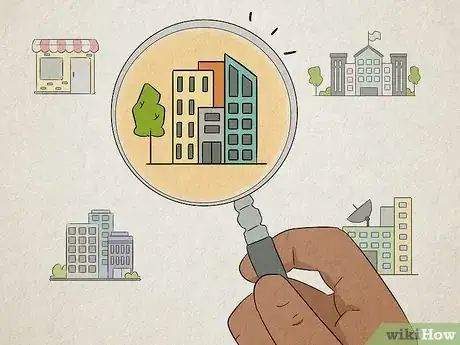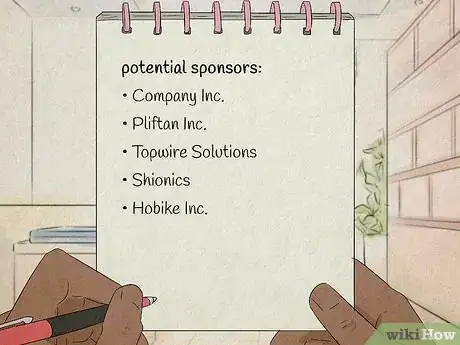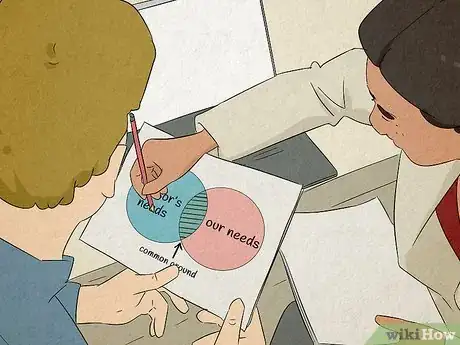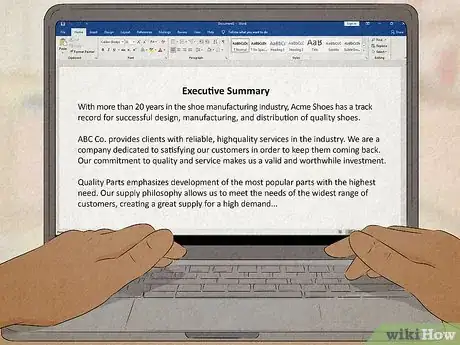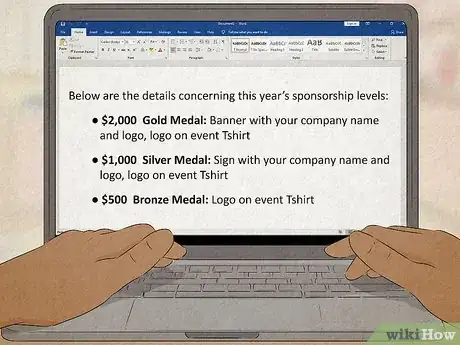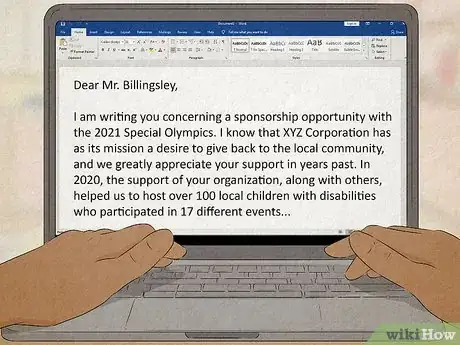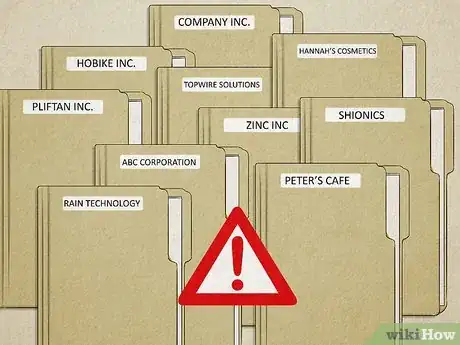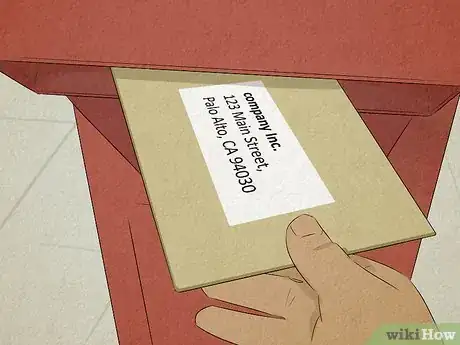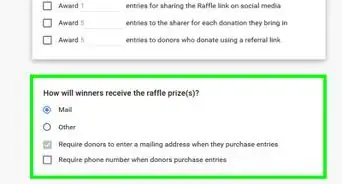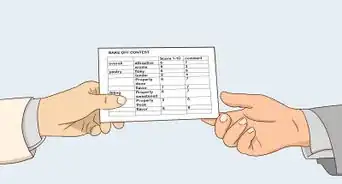This article was co-authored by Ernest Sturm. Ernest Sturm is a Marketing Expert and the Owner of Runway Influence and Runway Waiters, as well as the President of Runway Collective. With over 10 years of experience as an entrepreneur, he specializes in producing social media campaigns and social brand activations. Runway Influence has a 5-star rating and partners with luxury brands and top influencers.
wikiHow marks an article as reader-approved once it receives enough positive feedback. This article has 28 testimonials from our readers, earning it our reader-approved status.
This article has been viewed 716,251 times.
Getting your business venture, project, or event sponsored by a major company can result in greater exposure and an increase in opportunities for you. However, to partner with a company, you’ll need to make a compelling argument for their involvement in your project. There are a few simple steps to creating professional and effective sponsorship packets.
Steps
Identifying Potential Sponsors
-
1Look for companies that sponsor other events or activities similar to yours. Use the research that other organizations have done before you to help give you an edge. If you are looking for a special event sponsorship for a walk or running event, look at other runs in your area and look at who the sponsors were. This could be a good place to start.[1]
- If your event is athletic in nature, consider Nike, Adidas, Livestrong, and other sports-related organizations as possibilities.
- If you're holding a music event or concert, consider local radio stations, music publications, and other ventures that have similar interests.
- If you're holding a food event, consider Gourmet magazine, the Food Network, and other big food conglomerates. Aim high.
-
2Create a list of potential sponsors. A big list of potential sponsors is great, but you don’t want to simply ask every person and company that you know to be a sponsor. Your list needs to be a list of actual potential sponsors, meaning people or companies that you think will actually consider your sponsorship request. Include companies that have been sponsors for you in the past, companies that have sponsored other ideas similar to yours and people or companies that you have a personal connection with that would be able to be a sponsor.Advertisement
-
3Research every company or person on your list. Having background information on the potential sponsor will go a long way in helping you gain a sponsorship. Look for reasons why it would benefit the potential sponsor to sponsor you.[2]
-
4Anticipate the needs of each potential sponsor. If you learn the demographics, business model, and the goals of your potential sponsors, you can start developing some sense of the way you might pitch the sponsorship.[3]
- For this reason, more localized businesses are often a safer bet than larger corporations like Nike. While Nike's certainly got the coin to throw around, they're also probably getting several hundred sponsorship requests in a given week. The local radio station or sporting goods store? Probably much less. And if your customer base overlaps, that's potential earned income for them.
- Consider leveraging potential sponsors against one another. If one sporting goods store from the West side of town has already pledged at a certain level, mention that to the sporting goods store on the East side of town. They'll get the hint.
Creating a Sponsorship Packet
-
1Write an executive summary. A sponsorship packet must always start out with an executive summary, or mission statement about the event or venture you hope to have sponsored. This should be around 250-300 words that describes in detail what a sponsorship will fund, why you seek sponsorships, and how being a sponsor will benefit them.[4]
- Your executive summary is your one chance to get the potential sponsor to continue reading, so don't write a cookie-cutter form letter. Write an individualized note to make the potential sponsor feel like you really took the time to learn about them and their company. This will also demonstrate to the potential sponsor that you will hold up your sponsorship promises throughout the partnership.
- Remember to thank the sponsor for considering your offer. Use a friendly and professional working tone in your letter, illustrating your level of seriousness and professionalism.
-
2List the different sponsorship levels. If you haven't already, outline your budget among the business or venture, and decide what it is you hope to acquire from sponsors. Create different "levels" of sponsorship that potential sponsors may commit to and explain what you are asking for at each level and why you need sponsors for each level.[5]
- Explain what’s in it for the sponsor. Entice the potential sponsors by using your knowledge of their business model, audience, and goals, explaining how their sponsorship will benefit them. You might include arguments about press coverage and other promotional opportunities.
-
3Provide a call to action. Your call to action can be a form they fill out and send to you or your contact information asking them to call you to set up the sponsorship.
- Make sure that the sponsor has a specific task to fulfill in order to move the process forward. Keep the ball in their court. The easier it is for them to complete the task you're requesting, the more likely it is that they'll say yes.
-
4Cut to the chase. You're writing to marketers, entrepreneurs, and business people, not academics. This isn't the time to pad out your writing with lofty diction and fluff in an effort to sound smart. Make your argument, outline the business advantages for the sponsors, and end it quickly. Short and sweet.[6]
Sending out Packets
-
1Avoid the scattergun approach. It may be tempting to send out as many packets as possible to as many different places as possible, using a bland broadcast designed to reach as many different avenues as possible. Wrong. Be judicious in sending out packets, sending packets only to the companies you honestly think will work with your venture.
-
2Send the potential sponsors on your list your individualized sponsorship packets. Personalize every single email, packet, and correspondence you send out. Taking the lazy way out will only ensure that your project never gets the sponsorship it deserves.
-
3Follow up with a phone call. Wait a few days and then call the people you sent sponsorship packets to. Ask them if they have received your request. Find out if they have any questions. Make sure they know where to reach you when they make a decision.
-
4Customize your approach to each sponsor as they get on board. If you've got one company contributing $10,000 to your event, how will you treat them differently than the other company contributing a couple hundred bucks? The difference should be notable and substantial, from the perks you offer to the publicity to the way you talk with them on the phone. It's the time to wine and dine to make sure you keep them happy and on the hook.
Community Q&A
-
QuestionHow do I get a sponsorship to get started with college radio?
 Community AnswerSearch for small companies around you, like family restaurants, and offer them advertisement on air.
Community AnswerSearch for small companies around you, like family restaurants, and offer them advertisement on air. -
QuestionHow do I know that they have interest in my proposal?
 Community AnswerThey would write back or call you to say they are interested to help and ask more of what you want to achieve in the future with them.
Community AnswerThey would write back or call you to say they are interested to help and ask more of what you want to achieve in the future with them. -
QuestionHow do I get a sponsor for my soccer team?
 Community AnswerSports teams, especially for kids, usually have a lot of success with asking local restaurants and businesses to sponsor them. I would recommend coming up with a list of sponsorship levels and prizes (if any), and then approach some local business owners about possibly sponsoring your team. Your coach(es) should be able to help you.
Community AnswerSports teams, especially for kids, usually have a lot of success with asking local restaurants and businesses to sponsor them. I would recommend coming up with a list of sponsorship levels and prizes (if any), and then approach some local business owners about possibly sponsoring your team. Your coach(es) should be able to help you.
Expert Interview

Thanks for reading our article! If you'd like to learn more about seeking sponsorships, check out our in-depth interview with Ernest Sturm.
References
- ↑ https://blog.bizzabo.com/how-to-find-companies-interested-in-sponsoring-events
- ↑ https://www.themeboy.com/blog/find-sponsor-sports-team-sporting-event/
- ↑ https://www.fundingcentre.com.au/help/finding-sponsors
- ↑ https://www.entrepreneur.com/article/217913
- ↑ https://www.themeboy.com/blog/find-sponsor-sports-team-sporting-event/
- ↑ http://www.youngupstarts.com/2008/09/10/desperately-seeking-sponsorships-a-how-to-guide/
About This Article
Start seeking sponsorships by identifying companies that are involved in the same industry as your event or project. Once you have a list of potential sponsors, draft an executive summary of your venture, outlining the overall goals and how the sponsor will benefit. Then, put together personalized packages for each sponsor on your list, including the summary, a packet describing the suggested levels of sponsorship, and a form for contacting you for more information. For more tips on gaining sponsorship, including how to mail your packets, read on!
